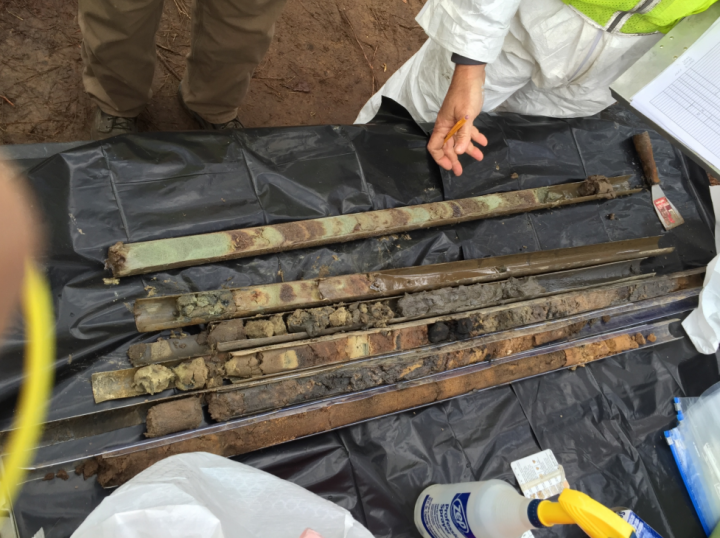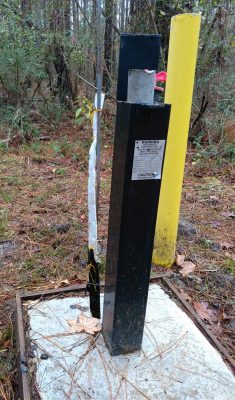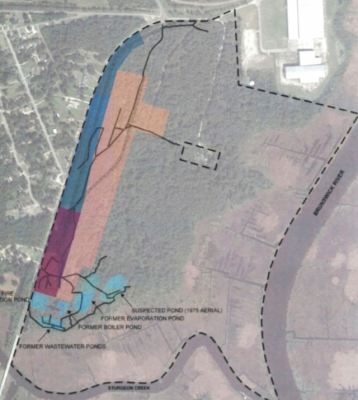
NAVASSA – As the investigation continues into how deep and widespread creosote has traveled through Navassa’s soil and groundwater, town leaders and residents must hatch plans to re-use the land where the wood-treating chemical was used and disposed of for years.
The Environmental Protection Agency, or EPA, is drilling additional monitoring wells throughout the town to determine where and how much contamination is in the ground from the former Kerr-McGee Chemical Corp. wood treatment facility.
During a public meeting hosted at the town’s community center Tuesday night, EPA, Multistate Environmental Response Trust and North Carolina Department of Environmental Quality officials updated residents on the latest results of soil and water tested for concentrations of the toxic sludge.
Creosote has been found as deep as 75 feet below the surface, said Richard Elliott, Multistate Trust project manager.
“Some of it is literally creosote,” Elliott said. “There are places, particularly in the production area where they were processing the ties and poles, it’s seeped down into the ground and it’s out there, no question about it.”
Supporter Spotlight
Creosote is sitting about 3½ feet deep at the bottom of one 65-foot-deep well, Elliott said.
That revelation drew audible “Mms” from several residents, many of whom shook their heads as they looked at pictures of a black, sludge-soaked cloth pulled from one well.
“You can see there are some places, by visual, that it’s very clean, and then you have creosote,” Elliott said. “We’re basically trying to draw a three-dimensional map of where this stuff is underground. How big is this? How deep is it? What does it look like? We’re trying to understand where that boundary is, but it’s a fairly good size, hundreds of feet in diameter, I would say.”

The Navassa site was once the location of a large plant that operated for nearly four decades treating wood with creosote, a common wood preservative made from a wide range of chemicals that, when combined, form a gummy substance applied to wood products such as railroad ties and telephone poles.
The plant opened in 1936 and was operated by numerous owners before being sold to the Kerr-McGee Chemical Corp., which closed the plant in 1974.
The 250-acre site was added to the EPA’s Superfund program’s National Priorities List in 2010.
In December 2016, officials collected water from 49 monitoring wells. Of those, seven wells contained creosote at thicknesses ranging from 0.07 feet to nearly 3½ feet.
Up until now, the EPA has been sporadically sampling groundwater for traces of contamination. Moving forward, the EPA will collect groundwater samples every quarter.
Elliott said there does not appear to be much creosote in Sturgeon Creek, which runs south of Navassa. Sediment samples from the marsh are currently being evaluated, he said.
He and other officials attempted to answer a barrage of questions from residents wanting to know whether fish and shellfish from the creek are safe to eat and what people should do if they’re concerned about being exposed to contamination.
There are also lingering questions about how or if site cleanup and land re-use planning efforts may be affected by the new administration in Washington.
The EPA may be facing deeper budget cuts, more than the 25 percent initially reported after President Donald Trump took office in January. The president unveiled his preliminary budget plan Thursday, slashing $2.6 billion, or 31 percent, of EPA’s current funding and reducing the agency’s workforce by one-fifth.
The cuts include funding for the Superfund cleanup program.
“No comment,” was the response when CRO asked Franklin Hill, director of the Superfund Division of the EPA Southeast, what effect the cuts may have on work at the Navassa site.

“I would be lying if I said I hadn’t thought about it,” Navassa Mayor Eulis Willis said of the proposed cuts. “Yes, it’s a concern of mine. I don’t know how much I’ll be able to do if it affects us.”
Willis said he had not asked EPA officials with whom he’s familiar about the potential effects.
“Their jobs seem to be somewhat secure at the moment at least,” Willis said.
The president’s proposed budget “reins in” Superfund administrative costs and “would prioritize the use of existing settlement funds to clean up hazardous waste sites and look for ways to remove some the barriers that have delayed the program’s ability to return sites to the community.” The plan would reduce funding for the Hazardous Substance Superfund Account by $330 million.
In the meantime, the process to determine how the former wood-treatment plant site should be used is moving forward.

Cindy Brooks, the Multistate Trust managing principal, proposed Tuesday night the creation of a redevelopment working group that would include residents, town representatives, business owners and the Navassa Community Economic and Environmental Re-Development Corp., or NCEERC.
“The trust is not a developer,” Brooks said. “The implementation of whatever is going to happen out there on the land is going to happen by others. At the end of this process what we hope to have is a potential way to reuse the Kerr-McGee site.”
How much and where the contamination is will help shape just how the land may be used.
The trust is seeking volunteers to join the redevelopment group, which will be chartered next month. A stakeholders’ meeting to hash out two to three design plans is scheduled to be held in September, with a final preliminary plan available for review in December.
EPA officials are urging residents to get involved in the land-use planning process.
“That local input, that local control over what is going to happen is something that’s important to us,” said Erik Spalvins, EPA remedial project manager. “This is about deciding what this piece of property is going to be used for for the next 50 years.”
The EPA’s remedial investigation report is scheduled to be issued in September. A record of decision and a detailed design phase of how the land will be used will be released sometime in 2019 with construction most likely starting in either late 2019 or early 2020, agency officials said.







